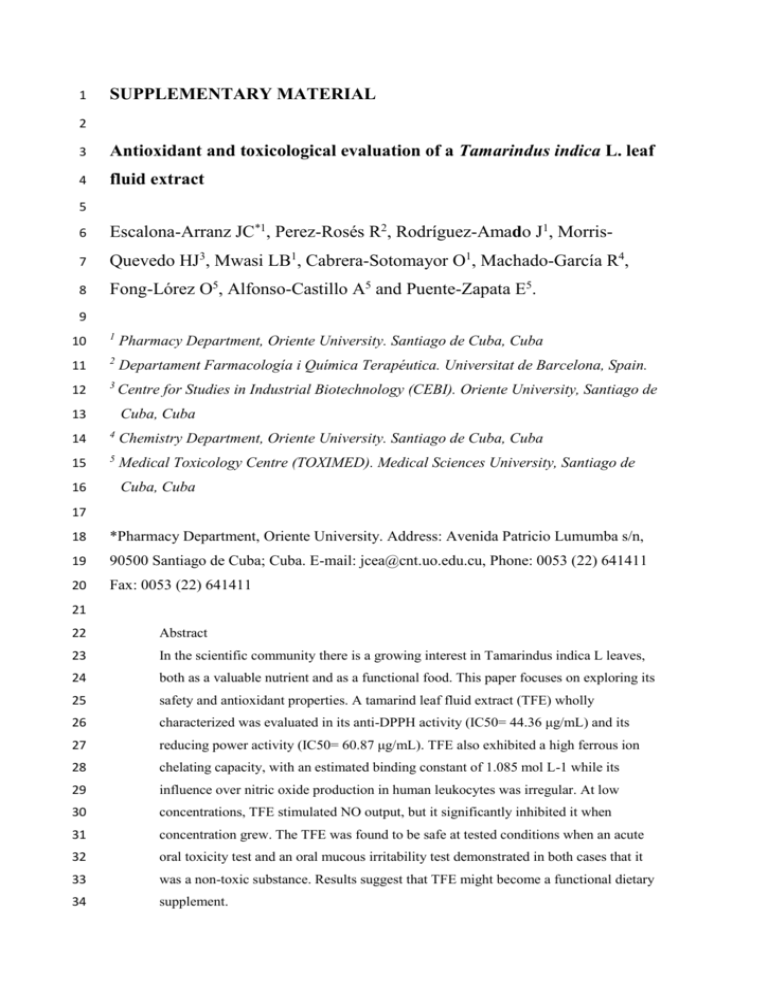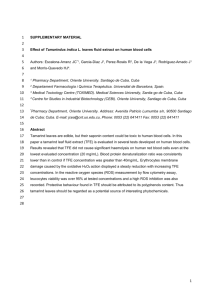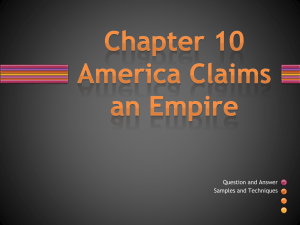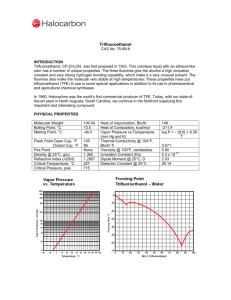Antioxidant activity and toxicity of Tamarindus indica L
advertisement

1
SUPPLEMENTARY MATERIAL
2
3
Antioxidant and toxicological evaluation of a Tamarindus indica L. leaf
4
fluid extract
5
6
Escalona-Arranz JC*1, Perez-Rosés R2, Rodríguez-Amado J1, Morris-
7
Quevedo HJ3, Mwasi LB1, Cabrera-Sotomayor O1, Machado-García R4,
8
Fong-Lórez O5, Alfonso-Castillo A5 and Puente-Zapata E5.
9
10
1
Pharmacy Department, Oriente University. Santiago de Cuba, Cuba
11
2
Departament Farmacología i Química Terapéutica. Universitat de Barcelona, Spain.
12
3
Centre for Studies in Industrial Biotechnology (CEBI). Oriente University, Santiago de
13
Cuba, Cuba
14
4
Chemistry Department, Oriente University. Santiago de Cuba, Cuba
15
5
Medical Toxicology Centre (TOXIMED). Medical Sciences University, Santiago de
16
Cuba, Cuba
17
18
*Pharmacy Department, Oriente University. Address: Avenida Patricio Lumumba s/n,
19
90500 Santiago de Cuba; Cuba. E-mail: jcea@cnt.uo.edu.cu, Phone: 0053 (22) 641411
20
Fax: 0053 (22) 641411
21
22
Abstract
23
In the scientific community there is a growing interest in Tamarindus indica L leaves,
24
both as a valuable nutrient and as a functional food. This paper focuses on exploring its
25
safety and antioxidant properties. A tamarind leaf fluid extract (TFE) wholly
26
characterized was evaluated in its anti-DPPH activity (IC50= 44.36 μg/mL) and its
27
reducing power activity (IC50= 60.87 μg/mL). TFE also exhibited a high ferrous ion
28
chelating capacity, with an estimated binding constant of 1.085 mol L-1 while its
29
influence over nitric oxide production in human leukocytes was irregular. At low
30
concentrations, TFE stimulated NO output, but it significantly inhibited it when
31
concentration grew. The TFE was found to be safe at tested conditions when an acute
32
oral toxicity test and an oral mucous irritability test demonstrated in both cases that it
33
was a non-toxic substance. Results suggest that TFE might become a functional dietary
34
supplement.
35
Keywords: Tamarindus indica L., antioxidant, toxicological evaluation, functional
36
foods, tamarind leaves
37
38
1. Experimental section
39
1.1. Plant material, chemicals and reagents
40
Tamarind leaves were collected from a tamarind population in Santiago de Cuba,
41
eastern Cuba (GPS 20º 2´38.9´´N and 075º 45´25.8´´W.), and were previously identified
42
by Dr. Jorge Sierra-Calzado. A voucher specimen registered as 052216 was deposited in
43
the Docent Section of The BSC Herbarium at the Biology Department of Oriente
44
University. Collected leaves were sun dried (residual humidity below 10% by the stove
45
method), milled (MLK, Russia), and passed across a mesh light sieve of 5 mm.
46
2,2-diphenyl-1-picryl hydrazyl (DPPH), quercetin, absolute ethanol, Hanks’ balanced
47
salt solution (HBSS) without Ca2+ and Mg2+, ethylenediaminetetraacetic acid
48
tetrasodium salt dihydrate (EDTA-Na4.H2O), ammonium chloride (NH4Cl), potassium
49
bicarbonate (KHCO3), formalin, Griess reagent (modified), L-arginine (L-Arg),
50
lipopolysaccharides (LPS) from Escherichia coli 0127:B8, NG-methyl-L-arginine
51
acetate salt (L-NMMA) and sodium nitrite (NaNO2) were obtained from Sigma
52
Chemical Company (St. Louis, MO, USA). Potassium ferricyanide, trichloroacetic acid,
53
ferric chloride and ferric sulfate were obtained from Beijing Chemical Reagents
54
Company (Beijing, China), meanwhile phosphate buffer, EDTA and Tris buffer were
55
supplied by Janssen Chimica (Belgium).
56
57
1.2. Tamarind extracts preparation
58
Extracting conditions were: 4 days of percolation and a mixture of ethanol/water 72%
59
v:v as solvent for the procedure. Previous experiences of our research group had proved
60
those conditions as a sure way to extract high quantities of metabolites (Escalona-
61
Arranz et al., 2011). The tamarind fluid extract (TFE) was prepared from 4 extractions
62
that were collected, mixed and concentrated up to 1 millilitre of extract for each
63
milligram of dried leaves. A vacuum evaporation system at 42 ºC (KIKA WERKE,
64
Germany) was used for the concentration of collected extractions. TFE had already been
65
characterized in its physico-chemical and chemical properties: total soluble substances,
66
pH, relative density, refraction index and total polyphenol and flavonoid content
67
(Escalona-Arranz et al., 2011). Quercetin, a well known antioxidant, was identified in
68
TFE and was likewise chosen as positive reference for all in vitro tests except that of
69
nitric oxide production in human leukocytes.
70
71
1.3. DPPH radical scavenging activity
72
The radical scavenging activity of the extract was evaluated using 2,2-diphenyl-1-
73
picrylhydrazyl (DPPH•) ( Brand-Williams et al. 1995). The fluid extract was lyophilized
74
(TELSTAR, LIOALFA-6, Spain) and dissolved in absolute ethanol to prepare seven
75
solutions ranging from 6.25 μg/mL until 400 μg/mL (12.5, 25, 50, 100, 200, 400).
76
Quercetin was used as standard in a range of 0.78 until 50.0 μg/mL. In brief: 2 mL of
77
the extract were added to 1 mL of DPPH (1 mM) in absolute ethanol. The mixture was
78
incubated at room temperature in the dark for one hour. The control was prepared as
79
above but without the extract. Absorbance at 517 nm was measured in a
80
spectrophotometer (RAY LEIGH UV-2601, China), using absolute ethanol as blank.
81
Scavenging activity was expressed as the inhibition percentage of the DPPH free stable
82
radical calculated using the following equation:
83
% Anti- radical activity = {(Control Abs.- Sample Abs.)/Control Abs.}x100
84
Data were normalized using the hyperbolic logarithm of the concentrations tested.
85
86
1.4. Reducing power assay
87
The reducing power was determined according to the method of Oyaizu (1986). The
88
fluid extract, lyophilized and dissolved in ethanol at five different concentrations (35,
89
70, 140, 220 and 280 μg/mL) was tested by the reducing power assay. In brief: 1 mL of
90
the extract was added to 2.5 mL of 0.2 M phosphate buffer pH=6.6 and 2.5 mL of
91
potassium ferricyanide (10 mg/mL). The mixture was incubated at 50°C for 20 min.
92
After incubation 2.5 mL of trichloroacetic acid (10.0 mg/mL) were added, the mixture
93
was centrifuged at 1160 x g for 10 min, and then 2.5 mL of the supernatant were mixed
94
with 2.5 mL of deionized water and 0.5 mL of ferric chloride (1.0 mg/mL). Five
95
different solutions (from 3.75 to 60 μg/mL) of quercetin were used as positive control.
96
Absorbance was then measured at 700 nm against a blank in the spectrophotometer
97
(RAY LEIGH UV-2601, China). Results were expressed as % antiradical activity. In
98
this experiment higher absorbance indicates higher reducing power. Data was
99
normalized using the hyperbolic logarithm of tested concentrations.
100
101
1.5. Ferrous ion chelating activity assay
102
For the ferrous ion chelating activity assay the technique described by Andjelković et al.
103
(2006) was followed with a minor modification. It was recorded the UV/visible
104
spectrum (200-800 nm) of the TFE (five concentrations from 0.4 until 6.4 mg/mL),
105
before and after adding rates of 0.01 and 0.1 mM ferric sulfate. The bathochromic shifts
106
experimented for the sample under consideration was evaluated when the ferric sulfate
107
was added. The wavelength in which the fluid extract-iron complex absorbs was thus
108
defined. The binding constant of the fluid extract with ferrous ions is defined as k=
109
intercept/slope, where intercept and slope are parameters of a linear relationship
110
between 1/(concentration) and 1/(absorbance of complexed ions). A quercetin solution
111
(from 0.76 until 0.228 mg/mL) was used as reference. The stability of the fluid extract-
112
iron complex was determined by addition of 0.01 and 0.1 mM of EDTA. An
113
absorbance’s decrease at the wavelength that absorbs the complex was considered as a
114
rupture in the fluid extract-iron complex. The percentage of leftover complex was
115
determined by measurement of the intensity of absorption of the complex, before and
116
after EDTA addition. In order to avoid oxygen interference all stock solutions were
117
freshly prepared before measuring and bi-distilled water and Tris buffer were subjected
118
to sonication for 45 minutes in an ultrasonic bath. All determinations were measured in
119
the spectrophotometer (RAY LEIGH UV-2601, China).
120
121
122
1.6. Nitric oxide production in human leukocytes
123
1.6.1. Isolation of human leukocytes
124
Leukocytes were isolated through a controlled haemolytic shock with an ammonium
125
chloride solution from buffy coats obtained from blood of healthy donors (Bossuyt et al.
126
1997). The pellet was suspended in modified HBSS. Buffy coats were obtained at the
127
Blood and Tissue Bank of Catalonia, under the approval of its ethical committee.
128
Identity of donors was always unknown.
129
130
1.6.2. Nitric oxide assay
131
In a 96-well U bottomed microtiter plate, all experimental wells received an aliquot of
132
200 μL of a suspension of human leukocytes (approximately 106 cells). Then, 20 μL of
133
the different treatment dilutions or modified HBSS (negative controls) were added.
134
Microtiterplates were incubated for 10 min in a stirred thermally controlled chamber at
135
37 ºC. After incubation, 20 μL of LPS (3 mg/mL) and 20 µL of L-Arg (2 mg/mL) were
136
added to all wells. A new incubation for 1 hour at 37 ºC and a centrifugation for 12 min
137
at 2700 rpm followed. After centrifugation, aliquots of 100 μL of supernatant in each
138
well were transferred to a 96-well flat bottomed microtiter plate and mixed with 100 μL
139
of Griess reagent. In measuring NO stable metabolites, the colorimetric detection with
140
the Griess reagent is the most commonly used technique (Griess 1879; Green et al.
141
1982). After 15 min at room temperature, absorbance was read at 540 nm on a
142
microtiter plate spectrophotometer, Benchmark Plus, BIORAD, USA. The amount of
143
nitrite was calculated from a NaNO2 standard curve. Supernatant from leucocytes not
144
exposed to LPS was used as negative control while NG-methyl-L-arginine acetate salt
145
(L-NMMA), a well known inhibitor of the enzyme nitric oxide synthase (NOS) was
146
used as positive control. Results were expressed as relative inhibition (%) of NO
147
production. Six concentration levels of TFE were considered (17.6, 35.3, 70.5, 141.0,
148
282.0 and 564.0 μg/ml). Concentration was plotted in logarithm form for both TFE and
149
L-NMMA.
150
151
1.7. Assays in animals and ethic considerations
152
Female Sprague-Dawley rats (150-200 g), 8-10 weeks old were employed in the acute
153
oral toxicity assay. A lineage of female outbred Syrian hamsters (50-60 g), 3-4 weeks
154
old were used in the evaluation of oral mucous irritability. Animals, in a perfect health
155
status, were supplied by the National Production Center for Laboratory Animals in
156
Havana, Cuba (CENPALAB by its acronym in Spanish). The animals were randomly
157
housed in appropriate cages at 22±3°C (on a 12 h light/dark cycle) with free access to
158
water and to a standard diet (CMO 1000) supplied by CENPALAB. Animals were
159
acclimated to their environment for 5 days before use for experiments. All tests
160
followed the “Good Laboratory Practices” as defined by the U.S. Food and Drug
161
Administration (FDA 2012). All experimental procedures using animals were in
162
accordance with ethical considerations established by the Ethics Committee of the
163
Toxicology and Biomedicine Centre (TOXIMED) from Santiago de Cuba Medical
164
University. Research protocols were also were approved by this same committee.
165
166
1.7.1. Acute oral toxicity evaluation
167
Methodology of this assay followed the proposal of the Organization for the
168
Cooperation and the Economic Development, according to the Acute Toxic Class
169
Method (OECD/OCDE 423). A group of seven animals was treated with a single dose
170
of 2000 mg/kg of TFE; meanwhile the control group (with the same number of animals)
171
was treated with solvent. During 14 days all behaviors and physical characteristics of
172
the animals were observed. Any changes in the skin or hair of the animal, color and
173
appearance of mucous membranes and eyes were registered daily, as well as water and
174
food consumption. Animals were weighed in days 0, 7 and 14 in a scale with a 0.01 g
175
precision (Sartorius, Germany). At the end of this period animals were sacrificed by
176
narcosis with an intramuscular ketamin's anesthetic dose. Anatomopathological studies
177
of the digestive system's organs were performed.
178
179
1.7.2. Oral mucous irritability
180
Two groups of five animals were formed (experimental and control). A cotton pellet
181
humidified with distilled water (control set) or TFE (experimental set) was placed in the
182
right malar bag of each animal during 5 minutes. This procedure was repeated four
183
times, once per hour. The mucous buccal appearance and the irritation grade in the
184
erythema were described for every animal according to a standard reference (ISO
185
10993-10). Animals were observed during 7 days after the application and weighed in
186
days 0, 4 and 7. Twenty four hours later, the oral mucous of every animal was
187
macroscopically examined and later they were sacrificed by cervical dislocation. For
188
histological tests, tissue samples of the application site were extracted and fixed in 10%
189
buffered neutral formalin for 48 hours. They were processed by paraffin embedding and
190
were stained with alum-hematoxylin and eosin. Tissue sections were examined
191
microscopically for histopathological change evaluation. The irritation index
192
classification was developed according to the standard reference in use (ISO 10993-10).
193
194
1.8. Statistical analysis
195
All data was reported as the mean ± standard deviation (SD). For the DPPH assay
196
results from six independent measurements were recorded. Relative inhibition of NO
197
production was the outcome from four independent measurements. Meanwhile in the
198
reducing power assay and the ferrous ion chelating activity assay results considered
199
three independent experiments. Inhibitory concentration 50% (IC50) was calculated by
200
interpolation in a concentration/effect curve when possible. StatGraphics plus (version
201
5.0.1 for Windows, MA, USA) was used to carry out a one-way analysis of variance
202
(ANOVA). When significant differences were detected by ANOVA, analyses of
203
differences between the means were performed using the Tukey's HSD (Honestly
204
Significant Difference Test). Two means comparison was execute by the Student's t-
205
test. Values were considered significant at p < 0.05.
206
207
References
208
Andjelković M, Van Camp J, De Meulenaer B, Depaemelaere G, Socaciu C, Verloo M,
209
Verhe R. 2006. Iron-chelation properties of phenolic acids bearing catechol and
210
galloyl groups. Food Chem. 98(1): 23-31.
211
http://dx.doi.org/10.1016/j.foodchem.2005.05.044
212
Bossuyt X, Marti GE, Fleisher TA. 1997. Comparative analysis of whole blood lysis
213
methods for flow cytometry. Cytometry (Part A). 30(3):124-133.
214
http://dx.doi.org/10.1002/(SICI)1097-0320(19970615)30:3<124::AID-
215
CYTO3>3.0.CO;2-L
216
Brand-Williams W, Cuvelier ME, Berset C. 1995. Use of a free radical method to
217
evaluate antioxidant activity. Lebensm.-Wiss. u.-Technol. 28(1): 25-30.
218
http://dx.doi.org/10.1016/S0023-6438(95)80008-5
219
Escalona-Arranz JC, Rodríguez-Amado J, Pérez-Rosés R, Cañizares-Lay J, Sierra-
220
González G, Morris-Quevedo HJ and Licea-Jimenez I. 2011. Metabolites
221
extraction optimization in Tamarindus indica L. leaves. Bol Latinoam Caribe
222
Plant Med Aromat. 10(4): 359-369.
223
224
225
FDA. 2012. Good laboratory practice (GLP) for non clinical laboratory studies. 21 CFR
Part 58. http://www.fda.gov/ohrms/dockets/98fr/980335s1.pdf
Green LC, Wagner DA, Glogowski J, Skipper PL, Wishnok JS, Tannenbaum SR. 1982.
226
Analysis of nitrate, nitrite, and [15N] nitrate in biological fluids. Anal.
227
Biochem. 126(1): 131-138. http://dx.doi.org/10.1016/0003-2697(82)90118-X
228
Griess P. 1879. Bemerkungen zu der abhandlung der H.H. Weselsky und Benedikt
229
"Ueber einige azoverbindungen". Berichte der deutschen chemischen
230
Gesellschaft. 12(1): 426-428. http://dx.doi.org/10.1002/cber.187901201117
231
ISO 10993-10. 2010. International Standard Organization. Biological Evaluation of
232
Medical Devices, part 10. Test for irritation and skin sensitization.
233
234
235
OECD/OCDE 423. 2012. OECD Guideline for Testing of Chemicals. Acute Oral
Toxicity–Acute Toxic Class Method.
Oyaizu M. 1986. Studies on products of browning reactions: antioxidative activities of
236
products of browning reaction prepared from glucosamine. Jpn J Nutr. 44(6):
237
307–315.







